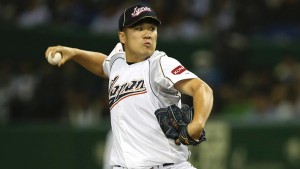
Earlier today, the New York Yankees announced it signed Masahiro Tanaka to an unprecedented seven-year, $155 million contract. This is the fifth richest contract for a pitcher in MLB history. The deal should come as no surprise to baseball fans and MLB teams after Tanaka selected Casey Close of Excel Sports Management to represent him. Close has been making noise as an MLBPA agent since the early 1990’s and most recently made MLB history negotiating the most lucrative contract for a pitcher—Clayton Kershaw’s seven-year, $215 million deal with the LA Dodgers. Last off-season, Close helped Zach Greinke secure a six-year $147 million deal with the LA Dodgers. Let’s not forget, in 2010, Close negotiated Derek Jeter’s three-year, $51 million contract with the Yankees and Jeter was 36 years old at the time.
In 2012, the Texas Rangers inked Japanese pitcher, Yu Darvish, to a six-year, $60 million deal (Rangers paid a $51.7 million posting bid), and Darvish is currently slotted as the Rangers’ ace for the upcoming season. The Red Sox in 2007 signed Daisuke Matsuzaka to a six-year, $52 million contract after paying a hefty, $51.1 million posting bid.
The new Japanese posting system increases the value that a top-of-the-rotation pitcher, like Tanaka, can demand. The old system had its flaws, forcing a MLB team to negotiate with the Japanese team, not the player, to first obtain the player’s exclusive rights. Once the MLB team obtained those rights, the team was free to negotiate exclusively with the player. The new system allows a flat $20 million fee to be paid to the Japanese club for the player to become a MLB free agent, allowing any team to negotiate for his services. It creates an open market for the Japanese player among MLB teams, which allows the free agent player to demand a higher salary. The new posting system coupled with Tanaka’s last season in Japan, where he posted an incredible 24-0 record and a 1.27 ERA, substantially increased his leverage for a higher salary than Yu Darvish was able to demand. (For more information see Andrew Marchand’s article at http://espn.go.com/new-york/mlb/story/_/id/10331816/masahiro-tanaka-new-york-yankees-agree-seven-year-155-million-deal)
Tanaka’s deal likely is the result of the success Yu Darvish has had in his first two seasons in the majors, averaging an ERA of 3.34 and 249 strikeouts. The deal will most certainly be worth every penny if Tanaka is good enough to slide into the second position in the Yankees’ rotation. But, there is always the risk that Tanaka’s talent will not translate to the major league and the Yankees could be overpaying for an average arm, like Daisuke Matsuzaka. That’s the risk Hank Steinbrenner and Brian Cashman are willing to take in order to position the Yankees to once again battle for the AL East pennant.
For more analysis, check out Darren Heitner’s article on Forbes: http://www.forbes.com/sites/darrenheitner/2014/01/22/tanakas-155-million-and-kershaws-215-million-means-excel-sports-is-having-a-wonderful-winter/.
